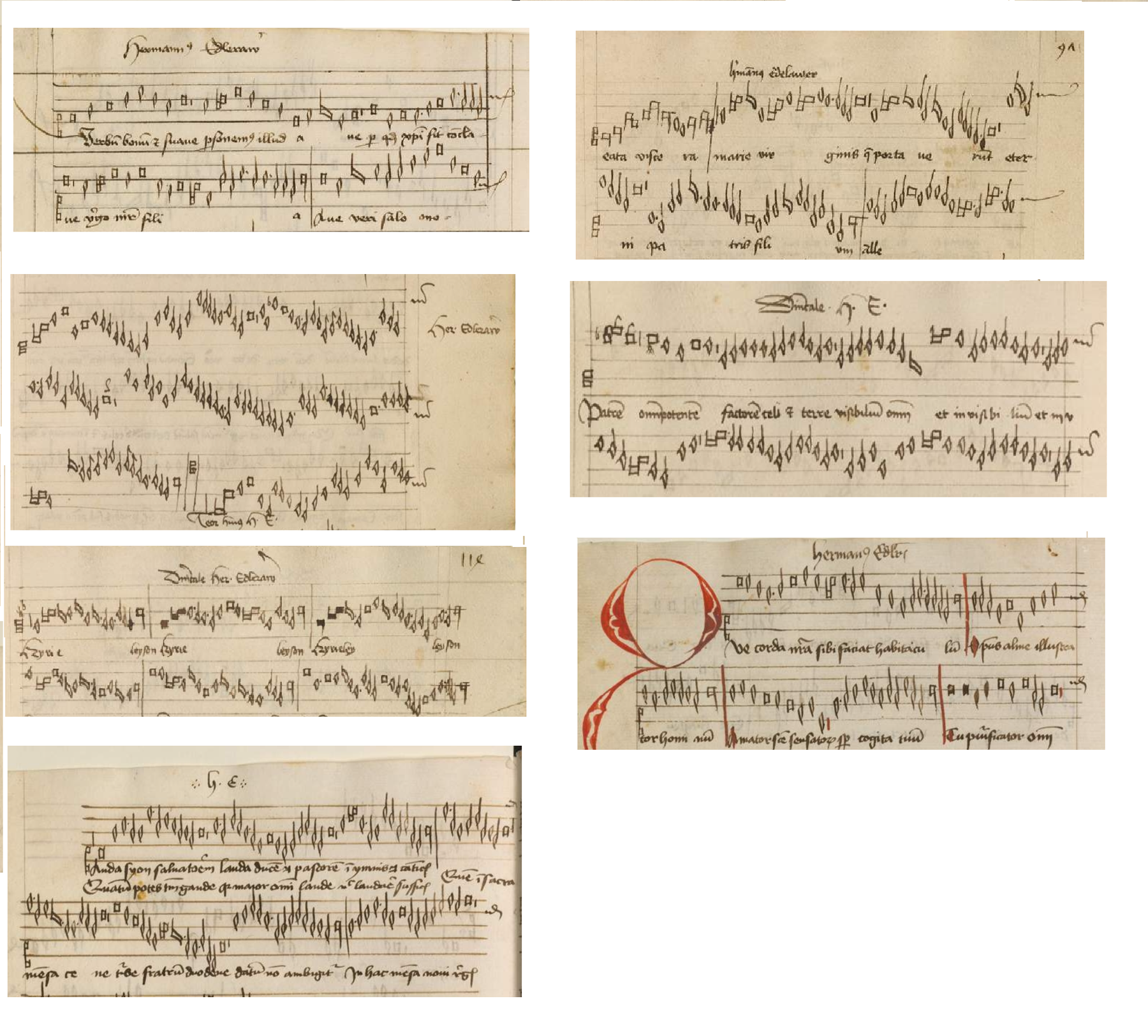The compositions of Hermann Edlerawer
Seven polyphonic compositions are ascribed to Edlerawer in Hermann Pötzlinger’s music book (» D-Mbs Clm 14274), the compilation of which more or less coincided with the former’s cantorship at St. Stephen’s. Pötzlinger graduated as a BA at the University of Vienna in 1439 (» G. Hermann Poetzlinger). In some cases Edlerawer is identified in D-Mbs Clm 14274 by his initials only (‘H.E.’), suggesting a degree of familiarity between him and the circle in which the manuscript was created (» Abb. Edlerawer in Clm 14274).
This is the only musical source in which Edlerawer is mentioned by name, though one of the compositions, the sequence setting Lauda Sion, also appears anonymously in » I-TRcap 93* (» Hörbsp. ♫ Lauda sion salvatorem, Edlerawer). Six of Edlerawer’s surviving compositions are sacred in character, while the seventh is a secular work in the form of a rondeau (» Hörbsp. ♫ Rondeau Edlerawer). The rondeau was copied into D-Mbs Clm 14274 without its vernacular text, probably with the intention of adapting it to sacred use at a later stage. The years during which Edlerawer was cantor at St. Stephen’s (c.1439–c.1444) may be the only period of his life during which he had a significant engagement with music: He was either directly or indirectly involved during that time in teaching the boys of the choir to sing not only the staple diet of plainsong but also mensural polyphonic music. It seems likely that all of his surviving music was composed during that period.
The nature of Edlerawer’s surviving works reflects the fact that music was only a peripheral concern in the context of his career as a whole. For example, fauxbourdon – a simple form of three-part polyphony, derived from techniques of improvisation, in which the middle voice merely duplicates the upper voice a fourth below, while the tenor alternates between the sixth and the octave beneath the upper one – was normally used by other composers only for short compositions or for short sections within longer works. However, it was also employed by Edlerawer for a whole setting of the long text of the Credo, as well as for all of the alternate verses (in alternation with plainsong) of two whole sequences, the Pentecost text Sancti spiritus assit nobis gracia and the Marian text Verbum bonum.
Most polyphonic music of the time is in three parts, but three further works by Edlerawer – a Kyrie setting, a setting of the Marian communion Beata viscera and a textless song – are preserved in only two (discantus and tenor). This may indicate that he did not compose third (contratenor) parts for these works, or it may simply reflect the fact that the scribes of D-Mbs Clm 14274 (or of the sources from which they were copying) often did not copy out the contratenors, even of works for which they are known to have existed.
Edlerawer’s most ambitious work is the setting of alternate verses of the Corpus Christi sequence Lauda Sion, which is preserved incomplete in both D-Mbs Clm 14274 and I-TRcap 93*, but which included a full range of the techniques available at the time – contratenor parts, fauxbourdon, chant paraphrase, different mensurations (time signatures), imitation between two or even three parts, and so on – artistically used to create contrast between the verses.
Edlerawer’s music, then, may be modest in both quantity and quality, but the detailed knowledge we have of his life and career provides us with a fascinating case study of the engagement of a fairly important person of his time with the practice of polyphonic music in Vienna.
[1] Rumbold /Wright 2009, 42–44. Edlerawer’s employment may have ended some time between 1444 and 1449. The records do not mention the holder of the office by name in those years.
[2] Strohm 2001, 17.
[3] Rumbold/Wright 2009, 47. On these and other public duties of the schoolboys, see » E. Musik im Gottesdienst and » H. Schule, Musik, Kantorei.
[4] Wagendorfer 2008, 48. on Aeneas Sylvius, see also » E. Musikbücher der Universität.
[5] Wiener Stadt- und Landesarchiv, Oberkammeramtsrechnungen (A-Wsa OKAR 1-55), Reihe I, Nr. 10 (1449), fol. 32r.
